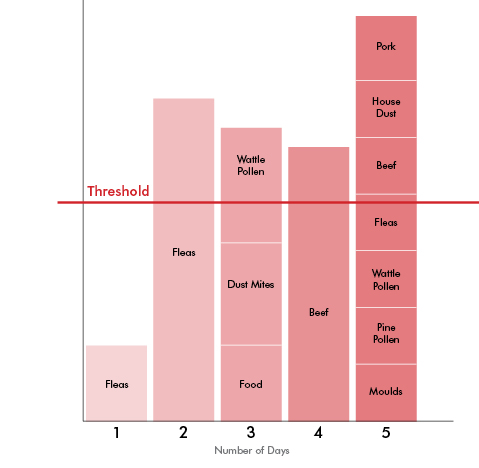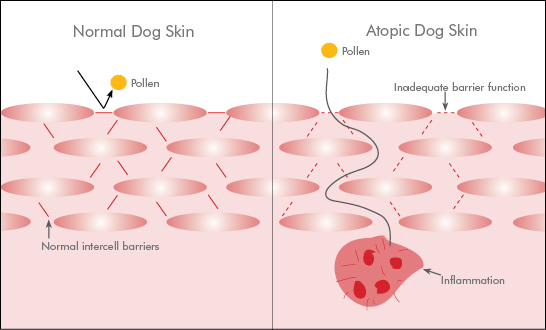Allergic Skin Disease
Allergic skin disease. 1 Causes and diagnosis
Allergic dermatitis (inflammation in the skin) is one of the most common diseases of dogs and cats, affecting about one in four dogs, in Australia, and slightly fewer cats.
Affected dogs usually scratch excessively and often develop bald patches. They may also chew or lick their feet more than normal, developing red moist areas between their toes, especially on the underside. It is also common for dogs with allergies to develop ear disease. The ears may initially become red and scaly. Secondary infection may then lead to them becoming wet smelly. This is often very painful.
Cats generally groom more than normal, and may have bald patches. They can also develop 'miliary dermatitis' when scabs, about the size of a grain of rice occur, all over their body (called miliary dermatitis as the scabs are supposed to resemble millet seeds).
Dogs and cats can be allergic to many different things. For convenience these are grouped as follows:
- Fleas and other biting insects
- Atopy. Airborne allergens such as pollens, dust and dust mites.
- Food. Usually the protein (meat) sources, but other allergies do occur.
- Contact
Threshold theory

There are also non-allergic causes of skin disease such as mites, and bacterial or fungal infections. Primary Inflammatory skin disease (that is not triggered by allergies) also occurs. These will be discussed later as these can be important from both a diagnostic and treatment perspective. It is also possible to get stress induced skin disease. This is unusual, but more common in cats than dogs.
As the diagram demonstrates, most animals are not allergic to a single allergen, but have many allergies, the sum of which causes their clinical disease.
In this diagram animal 1 has no allergic skin disease.
Animal 2 has a straight flea bite allergy.
Animal 3 has a mixed seasonal allergy. When the pollens are not present, even though the
other allergies will still be there, they will be below threshold so no clinical signs will occur
at those times.
Animal 4 has a food allergy. Dietary control will stop all clinical signs.
Animal 5 has a mixed non-seasonal allergy. These allergies cannot be controlled by
environmental manipulation.
Intermittent medication and various control measures should control the signs of disease well in dogs 1 to 4. Dog 5 will need ongoing treatment or a desensitization program.
Atopy
We now know that air borne allergens cause their effect not by being inhaled, but by being absorbed through the skin. It is thought that animals with atopy, as with people, have poor barrier function.
This means that in a normal dog or cat the cells of the skin are glued together, forming a barrier. In animals with atopy this glue is faulty. This allows air borne particles to penetrate further into the skin than they are supposed to, causing inflammation.

We will discuss techniques how can using this information can improve the efficiency of our treatments.
Most animals with atopy will not show signs before 6 months of age, but occasionally does occur earlier.
Food allergies
Overall food allergies account for about 7% of allergic dogs, however it is the most common allergic problem in dogs less than 6 months of age. Affected dogs will commonly chew their feet, and have affected ears, but lesions can occur anywhere. Cats often develop very itchy face and ears.
An elimination diet is used to rule out this form of skin disease, as the test methods used for atopy are unreliable for food allergies (see below). See our separate information sheet on running an elimination diet for your pet.
Diagnosis
Dogs with skin disease are often tested to first rule out non-allergic causes. If these tests are negative then it can be presumed the disease is allergic in origin. It can actually be quite hard to definitively prove allergies exist, as in some cases there is no definitive test to do so.
The tests listed below are performed in no set order, but are priorotised based on the index of suspicion for each disease in your pet. For example if we think food allergies are more likely than mites, we should do an elimination trial prior to skin scrapings. This information sheet is a general overview only, and we will discuss with you the individual needs of your pet.
Diagnostic options include:
1. Skin scrape. This is a simple procedure done during a consult or under light sedation
(depending on how many samples we need from your pet). The scrapes are examined
under a microscope for mites.
2. Cytology. This uses either scrapes, skin combings, or smears to assess the skin for
bacteria or fungal infection
3. Insect elimination trial. Animals with fleabite allergies can react to other insects
including ant bites. As such a 6-8 week comprehensive insect elimination plan can rule
out this disease. The aim is to stop any insect bites.
4. Thyroid function testing. Many dogs with underlying thyroid disease have symptoms of
skin disease
5. Skin biopsy. This can be used particularly to test for other, less common causes such
as auto-immune disease and tumours. Auto-immune disease occurs when animals
produce anti-bodies to their own tissues eg. Lupus
6. Dietary elimination trial to rule out food allergies.
7. Allergy testing. This is done either by blood or skin testing. Generally all the above
tests have been done first and we are attempting to find out what allergens are
problems for your pet so that we can get a vaccine made up against them.
Once we have a diagnosis we can work out a plan to best treat your pet. See the separate data sheets on elimination diets, treatment, and ancillary care of skin disease
Contact Us
1774 Mandurah Road, Port Kennedy WA 6172
Monday to Friday 7am to 7pm
Saturday 8am to 2pm
Sunday 10am to 2pm
smallanimalstaff@larkhillvets.com.au